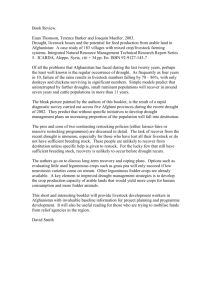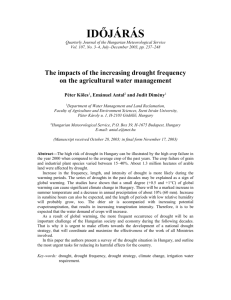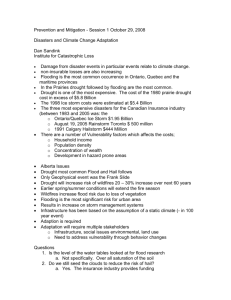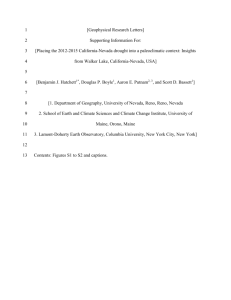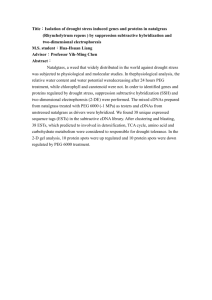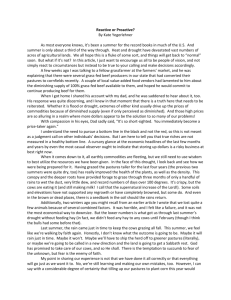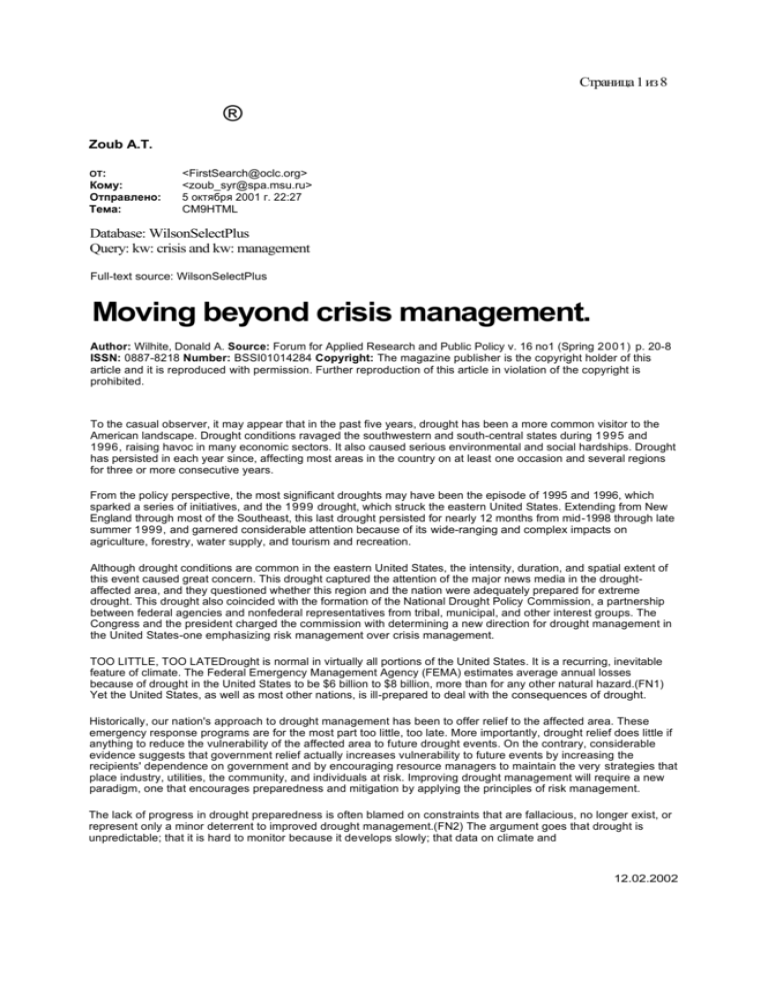
Страница 1 из 8
®
Zoub A.T.
ОТ:
Кому:
Отправлено:
Тема:
<FirstSearch@oclc.org>
<zoub_syr@spa.msu.ru>
5 октября 2001 г. 22:27
CM9HTML
Database: WilsonSelectPlus
Query: kw: crisis and kw: management
Full-text source: WilsonSelectPlus
Moving beyond crisis management.
Author: Wilhite, Donald A. Source: Forum for Applied Research and Public Policy v. 16 no1 (Spring 2001) p. 20-8
ISSN: 0887-8218 Number: BSSI01014284 Copyright: The magazine publisher is the copyright holder of this
article and it is reproduced with permission. Further reproduction of this article in violation of the copyright is
prohibited.
To the casual observer, it may appear that in the past five years, drought has been a more common visitor to the
American landscape. Drought conditions ravaged the southwestern and south-central states during 1995 and
1996, raising havoc in many economic sectors. It also caused serious environmental and social hardships. Drought
has persisted in each year since, affecting most areas in the country on at least one occasion and several regions
for three or more consecutive years.
From the policy perspective, the most significant droughts may have been the episode of 1995 and 1996, which
sparked a series of initiatives, and the 1999 drought, which struck the eastern United States. Extending from New
England through most of the Southeast, this last drought persisted for nearly 12 months from mid-1998 through late
summer 1999, and garnered considerable attention because of its wide-ranging and complex impacts on
agriculture, forestry, water supply, and tourism and recreation.
Although drought conditions are common in the eastern United States, the intensity, duration, and spatial extent of
this event caused great concern. This drought captured the attention of the major news media in the droughtaffected area, and they questioned whether this region and the nation were adequately prepared for extreme
drought. This drought also coincided with the formation of the National Drought Policy Commission, a partnership
between federal agencies and nonfederal representatives from tribal, municipal, and other interest groups. The
Congress and the president charged the commission with determining a new direction for drought management in
the United States-one emphasizing risk management over crisis management.
TOO LITTLE, TOO LATEDrought is normal in virtually all portions of the United States. It is a recurring, inevitable
feature of climate. The Federal Emergency Management Agency (FEMA) estimates average annual losses
because of drought in the United States to be $6 billion to $8 billion, more than for any other natural hazard.(FN1)
Yet the United States, as well as most other nations, is ill-prepared to deal with the consequences of drought.
Historically, our nation's approach to drought management has been to offer relief to the affected area. These
emergency response programs are for the most part too little, too late. More importantly, drought relief does little if
anything to reduce the vulnerability of the affected area to future drought events. On the contrary, considerable
evidence suggests that government relief actually increases vulnerability to future events by increasing the
recipients' dependence on government and by encouraging resource managers to maintain the very strategies that
place industry, utilities, the community, and individuals at risk. Improving drought management will require a new
paradigm, one that encourages preparedness and mitigation by applying the principles of risk management.
The lack of progress in drought preparedness is often blamed on constraints that are fallacious, no longer exist, or
represent only a minor deterrent to improved drought management.(FN2) The argument goes that drought is
unpredictable; that it is hard to monitor because it develops slowly; that data on climate and
12.02.2002
Страница 2 из 8
water supply are inadequate; that information delivery systems are inadequate; that a lack of coordination exists
between and within government agencies responsible for monitoring drought, managing water supply, and
planning for and responding to drought; and that suitable planning methodologies are unavailable. Drought
planning systematically addresses these constraints, whether perceived or real.
Scientists and professional organizations have issued numerous calls for action to develop a national drought
policy, but these have produced little in the way of progress. Yet, thanks to the National Drought Policy Act of
1998(FN3) and the subsequent report issued by the National Drought Policy Commission to Congress and the
president, we now can develop a coherent national policy that emphasizes drought preparedness and
mitigation.(FN4) We are at a critical crossroads for drought policy. Will we continue down the road of crisis
management or move toward risk management?
PROFILES OF DROUGHTDrought may be one of the most complex and least understood of all natural hazards,
affecting more people than any other hazard. It is a normal feature of climate and its recurrence is inevitable.
Confusion about its characteristics, however, has meant that effective management in most parts of the world has
received short shrift. Drought, in fact, is the Rodney Dangerfield of natural hazards; that is, it doesn't get the
respect that other natural hazards do, given the magnitude of its impacts. Scientists, policymakers, and decision
makers-including farmers and natural resource managers-need a better understanding of the phenomenon before
trying to establish plans that reduce vulnerability for future generations.(FN5).
Drought is different from other natural hazards such as floods, earthquakes, and tornadoes, which occur swiftly
and with clearly visible results. All droughts originate from a significant reduction in precipitation extended over a
season or longer. Humans can exacerbate drought, however, by over-allocating water supplies so demand may
greatly exceed supply in water-short years. Poor land management practices such as overgrazing can also degrade
the productivity of the natural landscape, thus increasing vulnerability to drought.
Many definitions of drought exist, reflecting the different climatic characteristics between regions and the wide
range of impacts that can occur on various economic sectors and the environment.
Droughts are commonly classified as meteorological, agricultural, and hydrological. Meteorological drought occurs
when there is a significant deficiency of precipitation compared with what is normal or expected over some
extended period of time. Agricultural drought results when deficiencies in precipitation lead to a reduction in soil
moisture that retards plant growth and development and, ultimately, yield. Hydrological drought, on the other hand,
occurs when an extended precipitation shortfall affects surface and subsurface water supply, which is measured by
monitoring stream flow, reservoir and lake levels, and groundwater.
Hydrological droughts are usually out of phase with meteorological and agricultural droughts since a time lapse
occurs between deficiencies in precipitation and the lowering of reservoirs or groundwater. In addition, water in
hydrological storage systems such as reservoirs and rivers is often used for multiple and competing purposes such
as drinking water, power generation, flood control, irrigation, and recreation. Competition for water in these storage
systems escalates during drought, increasing conflicts among water users.
No wonder there's a lack of progress in drought management. If scientists can't agree on what drought is, or how
severe it is, how can policymakers know when to act? A meteorologist, agronomist, and hydrologist may well
provide three distinctly different responses to the question, are we in a drought? More important, they may all be
correct.
Droughts occur more frequently in the West and usually last longer there, but the droughts of 1998 through 2000
have demonstrated the vulnerability of eastern states to severe and extended periods of low rainfall. Yet the West is
currently better equipped to manage water supplies during extended periods of water shortage because of large
investments in water storage and transmission facilities. Precisely because the eastern states have fewer droughts,
the region is generally less prepared to mitigate and respond to its effects.
Drought differs from other natural hazards in several critical ways, which complicates monitoring, impact
assessment, mitigation, and response. First, drought is a slow-onset, creeping, natural hazard, so it's hard to
determine when it begins and ends. Its effects often accumulate slowly over a considerable period of time and may
linger for years after the event is over. Scientists and policymakers continue to debate the criteria for declaring an
end to a drought.
12.02.2002
Страница 3 из 8
Second, the absence of a precise and universally accepted definition of drought adds to the confusion about
whether or not a drought exists and, if it does, its degree of severity. Realistically, definitions of drought must
be specific to regions and impacts.
Third, drought does not affect buildings, roads, and other structures, and it is more geographically
widespread than other natural hazards.
These peculiar characteristics of drought make quantifying its impacts and providing disaster relief far more difficult
than for other natural hazards. The National Drought Mitigation Center, however, recently determined that for the
48 contiguous states, severe and extreme drought affected more than 25 percent of the country in 27 of the past
100 years. During the drought of 1934, more than 60 percent of the 48 contiguous states experienced severe or
extreme drought conditions.
HUMAN COMPONENTMany people consider drought to be largely a natural or physical event. In reality, drought,
like other natural hazards, has both a natural and a social component, and human activity can either mitigate or
worsen the physical effects. Of course, we can't change the weather, or meteorological drought, which occurs
through persistent large-scale disruptions in the global circulation pattern of the atmosphere. But we can change
some of the social factors that determine our vulnerability to drought.
Our population is not only increasing but also shifting from humid to more arid climates-such as from the Northeast
and Midwest to the Sunbelt and the western states-and from rural to urban settings. Urban growth strains limited
water supplies and water supply systems, especially during periods of peak demand. An increasingly urbanized
population is also increasing conflict between agricultural and urban water users, a trend that will only be
exacerbated in the future.
As the population increases, so does pressure on natural resources. To improve drought management, we need to
use natural resources in a more sustainable manner. This will require a partnership between individuals and
government. Further complicating the picture, in the future the effects of drought will fall harder on some economic
sectors, population groups, and regions. Greater awareness of our environment and the need to preserve and
restore environmental quality is placing greater pressure on all of us to be better stewards of natural and biological
resources.
One thing is certain: continuing to address the effects of drought in a reactive, crisis-management mode will do
little to reduce the impacts of these events in the future. In fact, this approach has been shown to increase
vulnerability to drought in the long term because it increases dependence on government, which, in turn, decreases
self-reliance. If the government continues to bail out the people most affected by drought, they will have no incentive
to adopt methods to protect the natural resource base.
In arid and semi-arid Australia, the best land managers have learned that foresight and planning can lessen the
devastating effects of inevitable long dry spells. By applying appropriate farm management practices, farmers can
reduce many of the risks associated with drought, thus minimizing their losses. (FN6) Drought relief in Australia is
now provided only during exceptional drought conditions. In the United States, however, the recipients of drought
relief are typically those who do not implement appropriate management strategies when faced with impending
drought or those who manage the land resource in nonsustainable ways by overgrazing, planting inappropriate
crops, applying inappropriate tillage practices, or storing inadequate reserves of fodder for livestock. Urban areas
may seek federal or state grants or loans when water supplies are at risk when, in fact, longrange planning during
a non-drought period could have averted or reduced the risk.
Should society subsidize poor land and water managers or reward those who plan ahead or adopt appropriate
management practices? Risk management is aimed at the latter-crisis management, the former. The
implementation of a national drought policy in Australia in 1992 changed that nation's approach to drought
management. (See "Water Policy Adrift" in this issue of FORUM.) We should learn from their experience.
MITIGATING DISASTERIn the absence of a coherent national drought-management strategy, an increasing
number of states have stepped in to fill the void, creating their own drought plans during the past two decades.(FN7)
In 1982, only three states had drought plans in place. By 2000, 30 states had developed plans and six states were
at various stages of developing a plan. The basic goal of state drought plans should be to improve the effectiveness
of preparedness and response efforts by enhancing monitoring and early warning, risk and impact assessment, and
mitigation and response.
12.02.2002
Страница 4 из 8
Plans should also contain provisions to improve coordination within agencies of state government and
between local and federal government. Initially, drought plans largely focused on response efforts; today
the trend is for states to place greater emphasis on mitigation as the fundamental element of a drought
plan. Enhancing monitoring and early warning systems and conducting comprehensive risk assessments
of vulnerable population groups, economic sectors, and areas are key components of the planning
process.
/
Other mitigation strategies include public education, conflict resolution actions among water users, and measures
that augment supply and manage demand. Texas, for example, is developing a statewide drought plan that
includes a requirement for local communities to develop drought plans. Georgia's drought plan will include a state
framework with a series of more specific regional plans, such as for the metro Atlanta area and the Flint River basin.
Utah and Nebraska have revised their plans to further emphasize mitigation, and Colorado is in the revision
process. New Mexico, which first developed a drought plan in 1998, now has mitigation as the primary ingredient of
its plan. Texas, Hawaii, and Georgia are following a similar course. As states gain more experience with drought
planning and mitigation actions, the trend toward mitigation is expected to continue.
Initially, states were slow to develop drought plans because the planning process was unfamiliar. With the
development of drought planning models and the availability of a greater number of plans for comparison, drought
planning has become a less mysterious process.(FN8) As states initiate the planning process, they first study the
drought plans of other states to compare methodology and organizational structure.
The rapid adoption of drought plans is also a clear indication of their benefits. Drought plans provide the framework
for improved coordination within and between levels of government. Comprehensive, integrated early warning and
monitoring systems enhance the delivery of information to decision makers at all levels. Many states now use the
Internet to disseminate information to decision makers as well as to businesses, farmers, the banks that provide
loans to farmers, and individual homeowners. These websites provide current information on drought severity,
water-use restrictions, water conservation recommendations, key contacts within state and federal agencies, and
other timely information.
Through drought plans, the risks associated with drought can be better defined and addressed with active mitigation
and response programs. The planning process also allows the numerous stakeholders to be involved early and
often in plan development. This increases the probability that conflicts between water users will not escalate during
times of shortage. All of these actions can help to improve public awareness of the importance of water
management and the value of protecting our limited water resources.
LEADING THE WAYWith the tremendous advances in drought planning at the state level in recent years, it should
come as no surprise that states have been extremely frustrated with the lack of progress at the federal level. Early
into the 1995-1996 drought, the lack of leadership and coordination at the federal level quickly became obvious, as
attempts to access drought assistance programs were unsuccessful because federal programs had been
discontinued, were underfunded, or in some cases had not received appropriations from Congress.
Unlike other natural disasters where Federal Emergency Management Agency (FEMA) provides leadership and
coordinates federal response efforts, there is no lead federal agency for drought programs. This failure of
leadership continued in later droughts. Recent initiatives toward developing a national drought policy are the
direct result of those frustrations.
A national drought policy should establish a clear set of principles to govern the management of drought and its
impacts. The policy should be consistent and equitable for all regions, population groups, and economic sectors
and consistent with the goals of sustainable development.
Drought policy should emphasize risk management through the application of preparedness and mitigation. In
advance of drought, planning needs to be encouraged at all levels of government, monitoring and early warning
systems must be integrated and improved, risk assessments should be conducted, and mitigation actions and
programs should be identified and implemented. These actions will increase the level of readiness and improve
operational and institutional capabilities for responding to a drought. Mitigation-short-term and long-term actions,
programs, or policies implemented during and in advance of drought-reduces the degree of risk to human life,
property, and productivity.
12.02.2002
Страница 5 из 8
Emergency response, however, will always be a part of drought management since we cannot avoid or reduce all
potential impacts through mitigation programs. In addition, it is probable that a future drought will exceed the
drought of record and, therefore, the capacity of a region to respond.
Emergency response should be used sparingly, however, and only in a way that supports long-term goals and
objectives.
A national drought policy should also reduce risk by developing better awareness and understanding of the hazard
and the underlying causes of societal vulnerability. A risk-management approach promotes improved forecasts as
well as integrated monitoring and early warning systems, encourages preparedness plans and mitigation programs
at various levels of government, and supports a safety net of emergency response programs that ensure timely and
targeted relief.
SENSE OF URGENCYCalls for action on drought policy and plan development in the United States date back to at
least the late 1970s. Today, the federal government's failure to adequately address the spiraling impacts of drought
has provoked a growing number of calls for action.
Clearly, the traditional, reactive, crisis management approach, which has relied on ad hoc interagency
committees that are quickly disbanded following the end of a drought, isn't working. The lessons--the
successes and failures--of these responses have quickly been forgotten, and the failures are simply repeated
with the next event.
In response, a number of state organizations, scientific panels, and federal agencies-including the Western
Governors' Policy Office, General Accounting Office, National Academy of Sciences, Great Lakes Commission,
Interstate Council on Water Policy, U.S. Environmental Protection Agency, American Meteorological Society,
Office of Technology Assessment, FEMA, Western Governors'Association, and Western Water Policy Review
Advisory Commission--have issued calls for action.(FN9) The diversity of these stakeholders illustrates the extent
of drought's impact on the economy and environment and the growing concern over the ineffectiveness of prior
response efforts to address the complex, spiraling impacts of drought in a timely and equitable fashion.
More recently, in response to the severe impacts of drought in 1996, FEMA was directed to chair a multi-state task
force to address the drought situation in the Southwest and southern Great Plains states. The purpose of the task
force was to coordinate the federal response to problems in the drought-stricken region by identifying needs,
applicable programs, and program barriers. The task force was also directed to suggest ways to improve drought
management through short- and long-term national actions.
The final report contained several important long-term recommendations.
First, the task force called for the development of a national drought policy based on the philosophy of cooperation
with state and local stakeholders. This policy should include a national climate and drought monitoring system to
provide early warning of the onset and severity of drought to federal, state, and local officials.
Second, the task force suggested that a regional forum be created to assess regional needs and resources,
identify critical areas and interests, provide reliable and timely information, and coordinate state actions.
Third, the task force asked FEMA to include drought as one of the natural hazards addressed in the National
Mitigation Strategy, given the substantial costs associated with its occurrence and the numerous opportunities
available to mitigate its effects.
Fourth, states strongly requested that a single federal agency be appointed to coordinate drought
preparedness and response.
The drought of 1996 also spurred development of a drought task force under the leadership of the Western
Governors' Association. Formed in June 1996 as a result of a resolution offered by Governor Gary Johnson of New
Mexico, the task force emphasized the importance of a comprehensive, integrated drought response.
The task force made several important recommendations. First, a national drought policy is needed to
12.02.2002
Страница 6 из 8
integrate actions and responsibilities among all levels of government. The policy should emphasize
preparedness, response, and mitigation measures.
Second, states should develop contingency plans to provide early warning of drought to stakeholders, short- and
long-term mitigation and response programs, along with triggers for the start-up and shut-down of these programs.
Third, a regional drought coordinating council should be created to develop sustainable policy, monitor drought
conditions, assess state-level responses, identify impacts and issues for resolution, and work in partnership with
the federal government to address drought-related needs.
Fourth, a federal interagency coordinating group should be established with a designated lead agency for drought
coordination with states and regional agencies.
The FEMA and Western Governors' Association reports have spurred a number of important policy initiatives. In
early 1997, FEMA, Western Governors' Association, the Small Business Administration, and the U.S. departments
of Agriculture, Interior, and Commerce signed a memorandum of understanding calling for a partnership among
federal, state, local, and tribal governments to reduce drought impacts in the western United States. This MOU
resulted in the following actions:.
* The formation of the Western Drought Coordination Council to address the recommendations of the western
governors;.
* The designation of the USDA as the lead federal agency for drought, to carry out the objectives of the MOU; and.
* The establishment by USDA of a federal interagency drought coordinating group.
Concurrently, the Western Water Policy Review Advisory Commission, created by the Western Water Policy Act of
1992, reexamined western water policy.(FNIO) One of the reports published by the commission summarized
recommendations from recent studies on drought management that should be incorporated in future attempts to
integrate drought management and water policy in the West.(FN11) The consensus of these studies emphasized
the need to create a national drought policy and a national climate-monitoring system in support of that policy, as
well as to develop state drought mitigation plans. Although impacts of drought occur mainly at the local, state, and
regional level, this study concluded that it was imperative for the federal government to provide the leadership
necessary to improve the way the nation prepares for and responds to drought.
The severe drought of 1996 and the initiatives it inspired also led Senator Pete Domenici and Congressman Joe
Skeen of New Mexico to introduce the National Drought Policy Act of 1998 in Congress. This bill created the
National Drought Policy Commission to "provide advice and recommendations on creation of an integrated,
coordinated Federal policy designed to prepare for and respond to serious drought emergencies.".
In a report submitted to Congress and the president in May 2000, the National Drought Policy Commission
recommended that the United States establish a national drought policy emphasizing preparedness. The goals of
this policy would be to:.
* Incorporate planning, implementation of plans and mitigation measures, risk management, resource stewardship,
environmental considerations, and public education as key elements of an effective national drought policy;.
* Improve collaboration among scientists and managers to enhance observation networks, monitoring, prediction,
information delivery, and applied research, as well as foster public understanding of and preparedness for
drought;.
* Develop and incorporate comprehensive insurance and financial strategies into drought preparedness plans;.
* Maintain a safety net of emergency relief that emphasizes sound stewardship of natural resources and self-help;
and.
12.02.2002
Страница 7 из 8
* Coordinate drought programs and resources effectively and efficiently and in a customer-oriented
manner.
The National Drought Policy Commission further recommended creation of a long-term National Drought Council
composed of federal and nonfederal members to implement the recommendations of the commission. The
commission further recommended that Congress designate the secretary of Agriculture as co-chair of the Council,
with a nonfederal co-chair to be elected by the nonfederal council members. In late 2000, Secretary of Agriculture
Dan Glickman established an interim National Drought Council, pending action on a permanent council by the U.S.
Congress.
The true legacy of the 1995-1996 drought is not likely to be its economic, environmental, and social impacts, but
rather the policy initiatives that occurred in the post-drought period. These initiatives appear to be changing the way
droughts are viewed, and they may change the way droughts are managed in the United States. The real question
is whether these changes will result in permanent and substantive modifications in the way government entities deal
with drought.
CLOUDY FUTUREDrought is a normal part of climate for essentially all regions of the United States. Likewise,
drought relief has become a common feature of the national landscape. Shaped over the course of the past century
and a half, this relief occurs primarily under a diverse, complex, confusing, and poorly coordinated ensemble of
federal programs. It is reactive and does little to lessen the risks associated with future droughts. It is becoming
increasingly clear that current land and water-supply management practices are not sustainable in the long term,
especially given the variability of climate and the increasing demand on natural resources.
Although state and federal attention to improving drought management in the United States has been copious in
recent years, including the National Drought Policy Act of 1998, little change in practice is visible to date, especially
at the federal level. Federal response to drought conditions in 1999 and 2000 was reactive and short-term in
scope-in other words, business as usual. To fill the vacuum, states have continued to be the most progressive
actors in drought management, a trend that began in the early to mid-1980s. Regardless of progress by states,
improved drought management requires an integrated approach between and within levels of government.
True, federal agencies are now speaking the new language of drought management, and phrases like "improved
coordination and cooperation," "increased emphasis on mitigation and preparedness," and "building
nonfederal/federal partnerships" have become commonplace. Nevertheless, the mentality of most state and
federal government agencies remains response oriented.
Existing institutional inertia of federal emergency response programs and the expectations of the recipients of
assistance programs, however, encourage drought management to remain in a reactive, crisis-management
mode. It is not yet apparent whether federal and state policymakers clearly understand the scope of the changes
that will be required to invoke the new paradigm of risk management. When drought occurs, especially in election
years, drought relief is one method that members of Congress use to send money home to their constituents.
The true test of whether we are making progress will be if Congress and the administration enthusiastically
embrace the recommendations of the National Drought Policy Commission and other groups, provid e adequate
funding to support commission goals and recommendations, and direct federal agencies to modify existing policies
and programs to emphasize mitigation and preparedness. If they do, they will shift funding from crisis to risk
management and implement the new paradigm.
Only time will determine the dedication of the nation to this new approach to drought management. A continuation of
widespread, severe drought in the next few years would certainly engender greater support for this new paradigm
and help us continue down the path to risk management. The political will to change the way we manage drought
appears to be genuine but may evaporate quickly if we experience a series of wet years. Changing the momentum
of the past will be difficult, but it is critical for the scientific community and the public to hold policymakers to this
commitment.
Added material.
Donald A. Wilhite is director of the National Drought Mitigation Center and the International Drought
Information Center and a professor in the School of Natural Resource Sciences at the University of
Nebraska, in Lincoln.
12.02.2002
Страница 8 из 8
FOOTNOTES1. Federal Emergency Management Agency, National Mitigation Strategy (Washington, DC: FEMA,
1995), p. 2.
2. Donald A. Wilhite and William E. Easterling, eds., Planning for Drought: Toward a Reduction of Societal
Vulnerability (Boulder, CO: Westview Press, 1987), pp. 533-565.
3. National Drought Policy Act of 1998, 105 U.S.C. (section) 1 0 5 - 1 9 9 (1 9 9 8 ) .
4. National Drought Policy Commission, Preparing for Drought in the 2 1 s t Century (Washington, DC: NDPC,
2000), p. 48.
5. Donald A. Wilhite, ed., Drought: A Global Assessment (London, UK: Routledge Publishers, 2000), vol. 1-2, p.
700.
6. Bruce O'Meagher, M. Stafford Smith, and David H. White, "Approaches to Integrated Drought Risk
Management: Australia's National Drought Policy," in Wilhite, Drought: A Global Assessment, pp. 1 1 4 - 1 2 8 .
7. Donald A. Wilhite, "State Actions to Mitigate Drought: Lessons Learned," Journal of the American Water
Resources Association 33(5) (1997), pp. 961-968.
8. Donald A. Wilhite, "Planning for Drought: Moving from Crisis to Risk Management," Journal of the
American Water Resources Association 36(4) (2000), pp. 697-710.
9. Western Governors' Policy Office, Managing Resource Scarcity: Lessons from the Mid-seventies Drought
(Denver, CO: Institute for Policy Research, 1978), p. 78; General Accounting Office, Federal Responses to the
1976-77 Drought: What Should Be Done Next; (Washington, DC: GAO, 1979), p. 29; National Academy of
Sciences, The National Climate Program: Early Achievements and Future Directions (Washington, DC: NAS,
1986), p. 55; Great Lakes Commission, A Guidebook to Drought Management and Water Level Change in the
Great Lakes (Ann Arbor, Ml: Great Lakes Commission, 1990), p. 6 1 ; Interstate Council on Water Policy, Statement
of Policy 1991-92 (Washington, DC: ICWP, 1 9 9 1 ) , p. 39; J.B. Smith and D. Tirpak, eds., The Potential Effects of
Global Climate Change on the United States, EPA-230-05-89-050 (Washington, DC: EPA, 1989), p. 411;
American Meteorological Society, AMS Statement on Meteorological Drought (Boston, MA: AMS, 1997), pp. 847849; U.S. Congress, Office of Technology Assessment, Preparing for an Uncertain Climate, OTA-0-567
(Washington, DC: OTA, 1993), v. 1, pp. 250-257; Federal Emergency Management Agency, Drought of 1996:
Multi-State Drought Task Force Findings (Washington, DC: FEMA, 1996), p. 3 1 ; Western Water Policy Review
Advisory Commission, Water in the West: Challenge for the Next Century (Washington, DC: National Technical
Information Service, 1998), pp. 5-10.
10. Western Water Policy Review Act of 1992, 102 U.S.C. (section) 102-575 (1992).
11. Donald A. Wilhite, Improving Drought Management in the West (Washington, DC: National Technical
Information Service, 1997), p. 46.
FirstSearch® Copyright © 1992-2001 OCLC as to electronic presentation and platform. All
Rights Reserved.
12.02.2002



